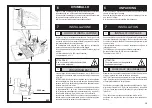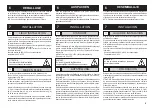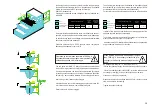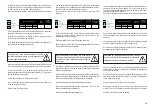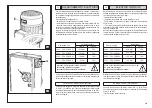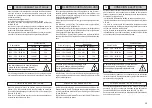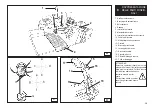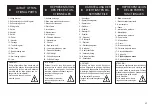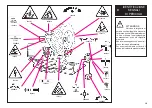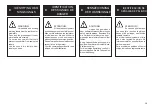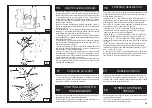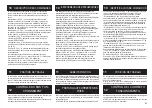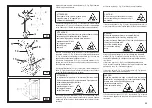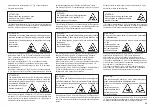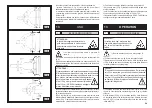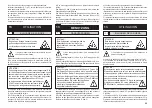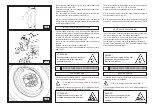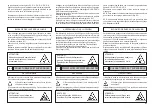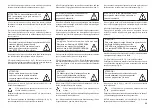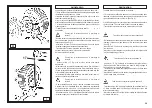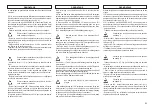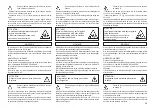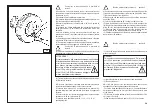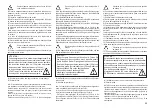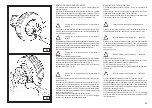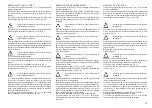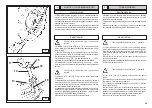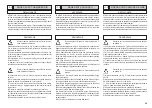
24
13.1
13.1
4) Verificare il buon funzionamento del circuito oleodinamico:
- azionare l'interruttore (5, Fig. C) verso l'alto fino a che i bracci
dell'autocentrante non siano completamente aperti.
- mantenendo l'interruttore in questa posizione (alto) verificare che
il manometro, posto sul raccordo girevole, indichi una pressione di
130 Bar ±10%.
Se la pressione indicata non rientra in questi valori, NON utilizzare
lo smontagomme e chiamare immediatamente il servizio tecnico di
assistenza.
4) Check to be certain the hydraulic circuit is working correctly:
- move switch lever (5, Fig. C) towards the top until the spindle arms
are fully extended.
- hold the switch lever in this position (top) and check if the pressure
shown on the gauge on the swivel fitting is 130 bar
±
10%.
If the pressure shown in not as indicated here, DO NOT USE the tyre
changer and call your nearest Assistance Centre.
2) Ribaltare in posizione di fuori lavoro il braccio porta-utensili (14,
fig. D).
3) Agendo sul manipolatore allontanare la pedana mobile (13, fig.
D) dall'autocentrante e farvi salire la ruota mantenendo la stessa in
posizione verticale.
BLOCCAGGIO RUOTA
LOCKING THE WHEEL
USO
13
13
OPERATION
ATTENZIONE !
In fase di bloccaggio assicurarsi che le
griffe siano posizionate in modo corretto
sul cerchione, onde evitare la caduta
della ruota.
WARNING!
In locking the wheel, make sure that
clamps are properly positioned on the
rim, so as to prevent the tyre from
falling
1) Portarsi con la colonnetta mobile in posizione di
lavoro B.
1) Take the mobile control unit to work position B.
2) Pull the tool-holder arm (14, fig. D) into the upright position.
3) Operating from the mobile control centre, move the sliding table
(13, fig. D) away from the self-centering chuck and place the wheel
in vertical position on the sliding table.
ATTENZIONE !
Questa operazione può essere estremamente pericolosa!
Effettuarla manualmente solo nel caso si sia assolutamente
sicuri di riuscire a mantenere in equilibrio la ruota. Le ruote
non devono mai essere sollevate dall'operatore, si
deve farle rotolare sul pavimento per ruote pesanti
oltre 110 kg e/o di grandi dimensioni (diametro
oltre 130 cm) si DEVE utilizzare un adeguato
mezzo di sollevamento meccanico.
4) Sempre agendo sul manipolatore alzare od abbassare il braccio
porta-autocentrante fino a centrare il più possibile l'autocentrante (3,
fig. A) rispetto al cerchio.
5) Con le griffe (22, fig. A) in posizione chiusa avvicinare la ruota
all'autocentrante traslando la pedana mobile, quindi agire sull'inter-
ruttore (5, fig. C) per aprire l'autocentrante e bloccare così il cerchio
internamente e nella posizione più conveniente
DANGER!
This operation can be extremely dangerous. Do it manually
only if you are certain you can keep the wheel balanced.
Heavy tyres (over 110kg) and/or oversize tyres (with diam-
eter over 130cm) shall never be lifted by hand. Let them roll
on floor and lift them by means of an adequate
mechanical lifting device.
4) Continuing to operate from the mobile control centre, lift or lower
the arm in order centre the self-centering chuck (3, fig. A) relative
to the rim.
5) With the jaws (22, fig. A) in the closed position, move the wheel
on the sliding table to the self-centering chuck. Operate the chuck
switch (5, fig. C) to open the self-centering chuck and lock onto the
inside wheel rim.
E/2
E/3
E/4
E/5
Содержание S 560
Страница 64: ...64 SCHEMA ELETTRICO SCHEMA ELECTRIQUE ELECTRIC DIAGRAM SCHALTPLAN 1...
Страница 65: ...65 SCHEMA ELETTRICO SCHEMA ELECTRIQUE ELECTRIC DIAGRAM SCHALTPLAN 2...
Страница 66: ...66 SCHEMA ELETTRICO SCHEMA ELECTRIQUE ELECTRIC DIAGRAM SCHALTPLAN 3...
Страница 67: ...67 SCHEMA IDRAULICO SCHEMA HYDRAULIQUE HYDRAULIC DIAGRAM HYDRAULIKPLAN...
Страница 68: ......

